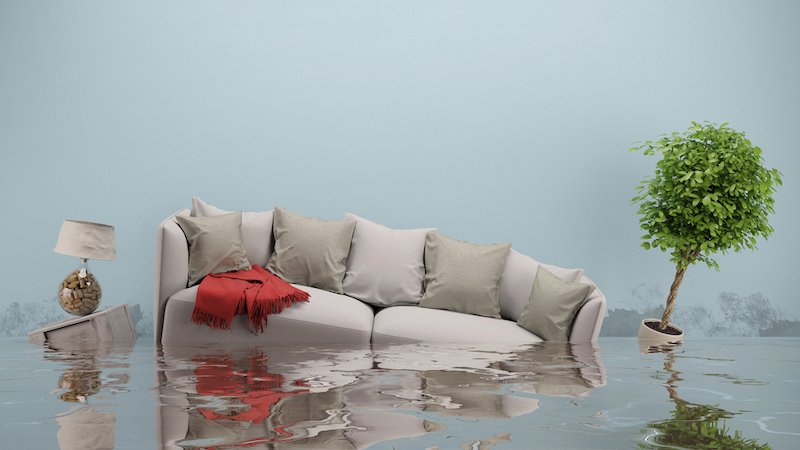Water damage can affect your house at any time and often occurs before you have any idea it’s happening. There are so many ways it can happen. It could be because of an unexpected flood or it could be because of a broken pipe. It doesn’t even have to be that dramatic. It could be an accumulation of condensation over the years that finally causes too much damage to ignore. This is a big problem for any homeowner but especially for those considering selling their house. How, exactly, can you sell a house that’s in need of serious repairs like this?
There are options for you, depending on your budget, timeframe, and desire to sell. You could always avoid any further headaches by selling to a cash buyer like Element Homebuyers. However, if you want to know how to sell a house with serious water damage on the open market, here’s what to know.
What To Know About Selling A House With Water Damage In Nebraska
Move Quickly
The most important thing you can do when you find out there is water damage is to act as fast as you can. Once water settles, it only takes 48 hours before mold sets in. And the longer things remain wet or damp, the easier it is for them to be destroyed or permanently damaged.
The most obvious thing you can do is remove everything you can from the flooded or wet area. Any furniture, boxes, clothing, or other items that can be easily moved should be. Not only should you move those things but you should also dry and clean all of them to minimize mold damage. Any clothing that was in or close to water should be washed quickly. Upholstery and fabrics should be taken to a cleaner who understands who to deal with them.
Next, get all of the fans and dehumidifiers you can and put them near the wet area. The fans will help dry things quicker while the dehumidifier will pull moisture out of the damaged area and room. This is especially critical in basements and dark rooms.
If you need to walk in a flooded area, make sure you are protected. There could be all kinds of bacteria or chemicals in the water and there may also be obstructions that you can’t see below the surface. Wear waterproof boots or waders, put on a mask, and invest in some quality rubber gloves.
Now that you’re in the damaged area, it’s important to document everything. You should be taking detailed pictures and video. You should also be documented every item that’s been damaged. And get the whole area close to the water damage noted as well, as there could still be damage that you haven’t seen. Not only is this important for insurance but it’s also important so you can show proof of the situation to any potential buyer.
Make Repairs
Whether you plan to sell the house or not, you’re going to have to fix the damage or find out how much it will cost to fix the damage. No good comes from letting a water damaged area fester, making wood weaker and staining carpets further. If you are going to sell the house on the open market, it’s unlikely you’ll be able to do so without making repairs. Buyers are not going to want to have to deal with the problems caused by water damage. Even if you do fix everything, the fact that it happened is always going to be a red flag, so it’s imperative not to give buyers more reasons to worry.
It’s probably a good idea to bring in a contractor for an estimate even if you think you can fix the damage yourself. Unless you are a real expert, it’s unlikely you’ll be able to assess all of the issues. There is the damage you can see and then there’s the damage you can’t see. That’s what a good contractor can spot and give you an assessment to fix. Make sure you get multiple assessments and quotes so you can compare. After the damage is repaired, consider having an inspection as well so that you have a third party agreeing that the proper repairs have been made.
If this all sounds like it might be costly, that’s true. There are a lot of costs involved in fixing water damage. It doesn’t just affect floors, it also affects walls, pipes, fixtures, and so many other things. And that’s before you get into whether or not mold has set in. You’re going to want to keep all of this in mind before rushing to sell your house on the open market.
Don’t Hide Anything
With all of the costs involved, you may want to just put a rug and some fresh paint on the damaged area and try to just push past it. But that’s a really bad idea. Buyers and lenders are bound to send in their own inspectors, who are sure to discover the damage no matter any efforts to hide it. And if they do, that’s probably going to ruin the sale as it’ll be tantamount to you trying to pull a fast one on the buyer. And even if you do somehow get away with it, it’s not uncommon for a buyer to discover undisclosed water damage after the fact and take the seller t court over it.
One extra tip for when you fix up the damaged area. Don’t just revert everything to how it was before. Use it as a chance to make the room the best it can be for potential sale. Use neutral colors for walls and flooring. That will help make this formerly damaged space seem fresh and clean. And absolutely make sure you don’t use any colors that might make people think of mold or mildew (greens, blues, and blacks).
Sell Your Home With Water Damage As-Is
So let’s say you’ve got extensive water damage and you can’t or just don’t want to pay the costs involved to get it fixed. Plus, you’re worried that you won’t be able to find a buyer on the open market anyway. You may want to consider selling the home to an investor like Element Homebuyers. They’ll buy the house as-is and they’ll give you a fair cash offer for it.
It’s common for homes with water damage to be sold to a real estate investor. It helps the seller avoid all of the costs and headaches that come with repairs, not to mention listing the home and dealing with all of the questions and concerns that come with it. An investor will give you a fair offer and take the home off your hands quickly so you can head to dryer land and make the most of your next house.



